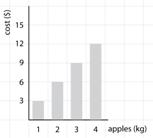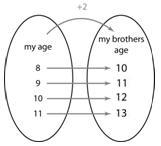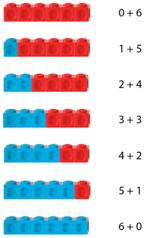The key idea of patterns and relationships at level 2 is that patterns can be described with a rule.
At this level, students learn that a sequential pattern requires a beginning point and a rule for the consistent growth of the pattern. Most often the growth from one term to the next is additive, where a geometric element, or a number is added to generate the next term in the sequence. For example:
Patterns also arise in the partitioning of numbers, a key idea that students will be using to solve number operations. For example, 6 can be partitioned into two parts in the following ways:
The 2 + 4 partition is useful to solve 8 + 6. Two is added to 8 to make a 10 which is an easy number to add the remaining 4.
At this level students begin to develop an understanding of additive and simple multiplicative relationships between variables, and the way these can be shown in diagrams and graphs. For example:
 |
 |
 |
This key idea develops from the key idea of patterns and relationships at level 1, focussed on exploring sequential and repeating patterns.
This key idea is extended to the key idea of patterns and relationships of level 3 where the students use, generalise and represent patterns and relationships in a variety of ways.

